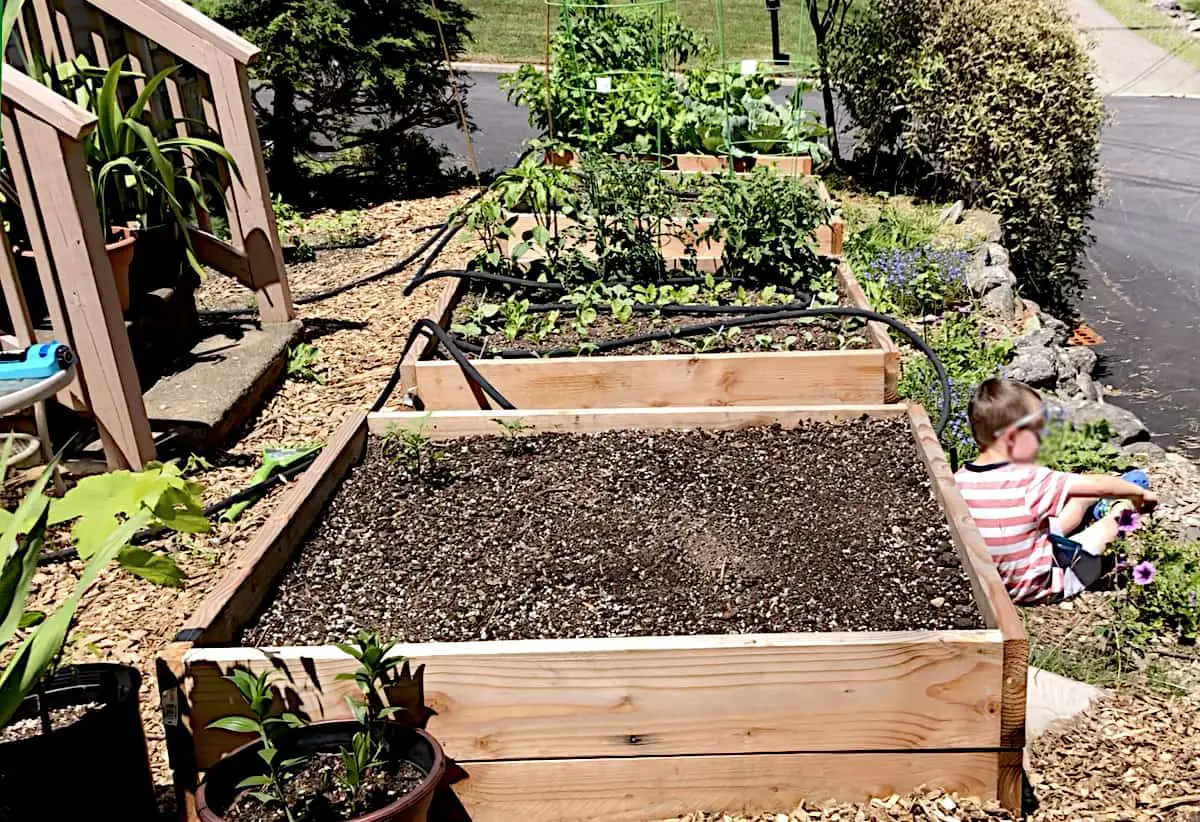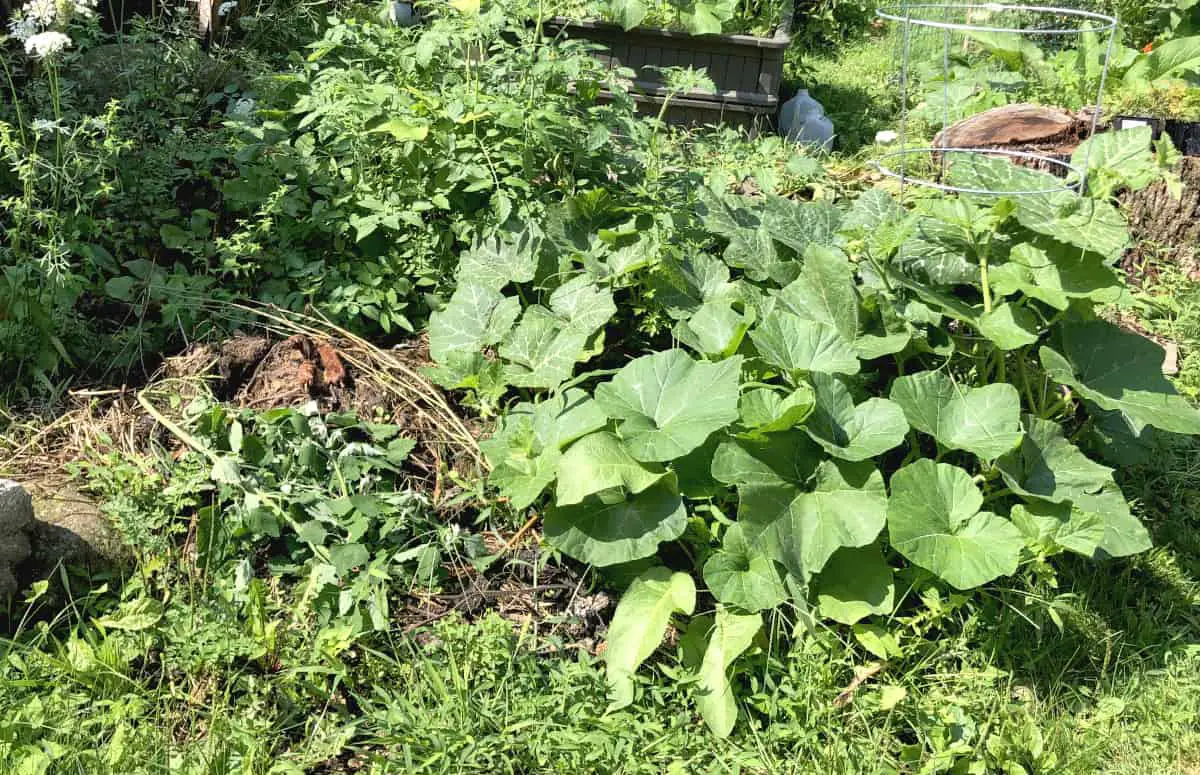There are endless recipes for DIY raised bed soil mixes. Not only every gardener you talk to has his own recipe, but they even change their recipes quite often. Here is one of the most used and popular DIY raised bed soil mix recipes.
Create a weed barrier by placing cardboard on the bottom of the garden bed. If your raised bed is deep, then use organic material around your yard or neighborhood like tree trimming, branches, and twigs. Then add smaller fillers that would fill up all the air pockets like grass clippings, leaves, pulled plants from the garden, and so, to fill half of the bed. This will break down over time and add organic matter to your garden bed. Keep the mix simple and thrifty. Add top soil which can be bought in bulk from a local landscape company, or if you can, source some from around your home. You can dig it up from the yard, or use old soil from your flower containers. Fill the rest of the garden bed with the nutrient-dense mix, with good aeration, and moisture retention. Add nutrients by adding compost, or fully composted mature, like chicken manure, cow manure, or rabbit manure. Compost will add good structure to the soil, along with nutrients. Fill the beds all the way to the top. Soil settles to the bottom over time. In addition, if you can, add other amendments such as worm casting, Azomite, leaf mold, and wood ash. Water your bed deeply. The garden bed is fully filled and ready to receive healthy seedlings and seeds!

When I get a new garden bed, I usually fill it with what I have available at that time and what I can source myself without buying. I do not really overthink my raised bed soil mixes, and I do not have a stiff formula to follow. I know that my plants need nutrition, I like trace minerals in my soil, and when my soil drains well while holding to a good amount of moisture. I like airy soil that is easy to plant in. I always add wood chips on the bottom of my garden beds, sticks, and anything really that once grew on my property and needs to be discarded. It adds a nice natural compostable barrier between any surface, stops the weeds and as they rot, they create nice organic matter. I simply like to use what I can source around me. The less I buy, the better for my valet and for my garden.
Then, I fill the bed with half bed of topsoil. Then I add a large portion of compost, a lesser part of peat moss, and pearlite. I like to add Azomite powder to my garden, wood ash we have left over from winter wood burning, and if I have, I also add leaf mold and worm castings. I collect leaf mold and worm casting in the woods, so I do not have it always available. I add these as I collect them and I mix them in when I can. Recently, I found a lady who has rabbits, and I plan to mix their castings in this growing season.
Compost, leaf mold, and worm castings are my favorite amendments to mix in. If I should choose only one thing to fill my beds with, it would be homemade compost. Over the years I discovered that there is no magical black gold sold in any garden center, or store. By the end of the growing season, I was disappointed with all the composts I have ever purchased. Some were better than others, but I did not buy any store-bought compost twice. My compost bed where I trench compost yielded the best! So, there you go, homemade compost is best.

One of the most important things to start with when you start a home garden is to start a compost pile. Just do it, you will understand later how important that was. Of course, I did not follow the advice when I started, and I regret it. I now know how important is to have your own compost pile. My pile could have been triple the size have I started composting as soon as I started my garden. I do cold compost pile, meaning I do not turn my compost, I simply dump everything in one pile from the top. And as needed I collect finished compost from the bottom. And I also trench compost in all of my garden beds over the winter when they are empty. In spring they are full of organic matter with composted kitchen scraps underneath. This trench composting improved my garden soil tremendously. The harvest reflected how well trench composting in garden beds works for me.
If you are looking for very detailed information about raised bed soil, and want to dig really deep into it, with all the details included, then I would recommend watching John Kohler’s video from Growing Your Greens, here. He talks in real detail about organic matter components, trace minerals components, carbon components and types, microbial components and types, and much more.
What to put on the bottom of the garden beds
Organic materials such as cartons, newspapers, tree logs, branches, twigs, grass clippings, woodchips, weeds from weeding, and simply everything that was once living and growing in nature can be put on the bottom of the garden bed. Over time it will rot and add nutrition and soil to the bottom of your garden bed while making a weed barrier, or barrier between your good soil and grass that will eventually die under the bed.
How to fill the upper part of garden beds
On top of that, I add topsoil. If I buy topsoil, I get it in bulk by the yards, so I still use the topsoil purchased about 3 years ago. I also reuse my old soil from containers and such. I add it just to leave about 6-10 inches of the top of the bed empty.
Then I fill the rest of the garden bed with about 2 parts of compost, and 1 part of these mixed together to make up 1 part: peat moss (also bought in bulk), pearlite, wood ash, warm castings, leaf mold, Azomite, and aged manure I have laying around from 2 years ago. I do not really measure anything; I eyeball it and feel it with my hands for structure.
TIP: If you buy anything for your garden, buy in bulk. It is cheaper over time and it will last you for years to come. You will save yourself a hustle to go to the store or your source, you save money, and you save labor. It will be available and handy to you at all times as you garden. For example. Do not buy a small bag of pearlite, but buy a large bag of 2–4 cubic feet. The same goes for everything, especially compost and topsoil mixed half with compost. Topsoil is cheaper than anything else and is a good base for the rest to mix in. Buy topsoil and compost by yards, if you have a place to store it, of course. This applies to everything including frost covers, garden mesh and garden ties.
TIP: Never throw away used, old soil. It can be reused, revived, and planned in it again. You do not have to purchase topsoil if you already have some you can use. I always reuse my soil and there is no way I would throw away any. If it is spent, then use it to fill the bottoms of your beds or containers. Or mix it with some good compost, amendments, and nutrients. It will still provide structure, fill the space, and hold moisture.
How to construct a raised bed garden for beginners

